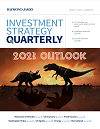Key determinants for 2022 economy: Inflation and Fed policy- Investment Quarterly Strategy
“Investors should be prepared for the ground to shift repeatedly in 2022,” says Raymond James Chief Economist Dr. Scott Brown.
To read the full article, see the Investment Strategy Quarterly publication linked below.
The U.S. economy experienced a number of surprises in 2021 – some good, some bad. The outlook for the coming year is likely to be even more volatile with inflation and Federal Reserve (Fed) policy as the major factors.
Key takeaways
- The outlook for the coming year is likely to be more volatile than 2021 with inflation and Federal Reserve (Fed) policy as the major factors.
- Key components of GDP – consumer spending and business fixed investment – rose at an annual rate of 11.7% and 11.1%, respectively, in the first half.
- Near-term inflation expectations have risen, but longer-term inflation expectations have remained consistent with the Fed’s goal.
- GDP growth should be slower, but still beyond a long-term sustainable pace. Our expectation is GDP growth will be approximately 3.5% in 2022.
Higher inflation in the spring of 2021 was narrow and expected to be transitory, but by the end of the year, there were growing fears of a more persistent, broader increase in inflation. With that, financial markets expect tighter monetary policy and a possible policy mistake. Time will tell, as they say, but investors should be prepared for the ground to shift repeatedly in 2022.
The Fed appears to face a tradeoff in 2022. If it waits too long to raise short-term interest rates and higher inflation becomes more rooted, it will eventually have to raise rates more to get inflation back down, slowing economic growth and risking a recession. Most likely, the Fed will begin to raise short-term interest rates by the middle of 2022 and proceed gradually, but a lot depends on the evolution of the economy.
Much of the growth in 2021 was a recovery from the pandemic. A key factor in the 2022 outlook is that there will be less to rebound from. With less ground to make up, GDP growth should be slower, but still beyond a long-term sustainable pace. Our expectation is GDP growth will be approximately 3.5% in 2022.
Fiscal policy will be contractionary compared to 2021. Labor market constraints are also likely to remain an impediment to faster growth. Higher wages should pull many back into the workforce, providing some upside to the growth outlook, but it’s hard to say for certain.
We’re unlikely to see another round of government support for individuals. At the same time, consumer spending growth should remain supported by a strong trend in wage and salary income. Some of the 2021 government support was saved, showing up in higher balances in checking and savings accounts. That savings will be reduced over time, but should provide some near-term cushion for spending.
While consumer spending did not shift back from goods to services in 2021, that ought to show up more in 2022 – but a lot depends on variants of the virus. A lockdown of the economy is unlikely, but fear of the virus may dissuade some individuals from returning to pre-pandemic spending patterns.
Strength in corporate profits supported business fixed investment in 2021. That support should continue in 2022, but at a more moderate pace. Geopolitical tensions could be an issue in 2022, but the Fed will be the major factor, with the policy outlook expected to vary with the incoming data. Investors should watch developments closely and be prepared..
Read the full Investment Strategy Quarterly
All expressions of opinion reflect the judgment the author, the Investment Strategy Committee, or the Chief Investment Office and are subject to change. Past performance may not be indicative of future results. There is no assurance any of the trends mentioned will continue or forecasts will occur.


